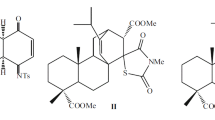Summary
The human biliary metabolism of the antitumor agent N 2-methyl-9-hydroxyellipticinium acetate is described. Three major compounds have been identified by high-performance liquid chromatography and comparison with synthetic reference derivatives: the unchanged drug, the O-glucuronide conjugate and the cysteinyl-ellipticinium adduct. The latter one is the expected detoxification compound of an intermediate electrophilic quinone-imine derivative generated in vivo. This result provides a further evidence that hydroxylated forms of ellipticine derivatives might be activated by a biooxidation route.
Similar content being viewed by others
References
Auclair C, Paoletti C (1981) Bioactivation of the antitumor drugs-9-hydroxyellipticine and derivatives by a peroxidasehydrogen peroxide system. J Med Chem 24:289–295
Clarysse A, Brugarolas A, Siegenthaler P, Abele R, Cavalli F, De Jager R, Renard G, Rozencweig M, Hansen HH (1984) Phase II study of 9-hydroxy-2N-methyl ellipticinium acetate. Eur J Cancer Clin Oncol 20:243–247
Dugué B, Meunier B, Paoletti C (1983) Synthesis of (0)-glucosides of N 2-methyl-9-hydroxy ellipticinium and related biological studies. Eur J Med Chem 18:551–554
Goldbarg JA, Friedman OH, Pineda EP, Smith EE, Chatterji R, Stein EH, Rutenburg AM (1960) The colorimetric determination of γ-glutamyl transpeptidase with a synthetic substrate. Arch Biochem Biophys 91:61–70
Jacoby WB, Habic WH, (1980) Glutathione transferases in Jacoby WB (ed) Enzymatic basis of detoxification, vol 2. Academic, London, pp 63–94
Juret P, Heron JF, Couette JE, Delozier T, Le Talaer JY (1982) Hydroxy-9-methyl-2-ellipticinium for osseous metastases from breast cancer: a 5-year experience. Cancer Treat Rep 66:1909–1916
Maftouh M, Monsarrat B, Rao R, Meunier B, Paoletti C (1984) Identification of the glucuronide and glutathione conjugates of the antitumor drug N 2-methyl-9-hydroxy ellipticinium acetate (Celiptium). Drug Metab Dispos 12:111–119
Meunier G (1982) Contribution à l'étude du mécanisme d'action d'une drogue antitumorale: l'acétate de méthyl-2-hydroxy-9 ellipticinium. PhD thesis, Toulouse University
Meunier G, Meunier B, Auclair C, Bernadou J, Paoletti C (1983) Unexpected regiospecific alkylation of the antitumor agent N 2-methyl-9-hydroxy ellipticnium acetate with N, O or S donors. Tetrahedron Lett 24:365–368
Monsarrat B, Maftouh M, Meunier G, Dugué B, Bernadou J, Armand JP, Picard-Fraire C, Meunier B, Paoletti C (1983) Human and rat urinary metabolites of the antitumor drug Celiptium (N 2-methyl-9-hydroxyellipticinium acetate, NSC 264 137). Identification of cysteine conjugates supporting the “biooxidative alkylation” hypothesis. Biochem Pharmacol 32: 3887–3890
Tate SS (1980) Enzymes of mercapturic acid formation Jacoby WB (ed) In: Enzymatic basis of detoxification, vol 2. (ed) Academic London, pp 95–120
Author information
Authors and Affiliations
Additional information
Part of this work was done by J. B. as part of his preparation for the degree of Doctor of Medicine in the Centre Claudius Regaud
Rights and permissions
About this article
Cite this article
Bernadou, J., Monsarrat, B., Roche, H. et al. Evidence for electrophilic properties of N 2-methyl-9-hydroxy ellipticinium acetate (Celiptium) from human biliary metabolites. Cancer Chemother. Pharmacol. 15, 63–65 (1985). https://doi.org/10.1007/BF00257297
Received:
Accepted:
Issue Date:
DOI: https://doi.org/10.1007/BF00257297




